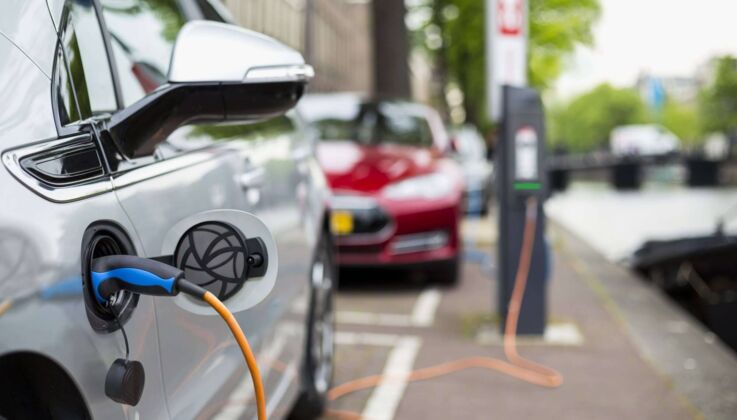
SAFETY AND LONG DRIVING DISTANCE
EV battery components with fumed silica and metal oxides from Evonik
Car manufacturers are constantly optimizing their electric vehicles (EV) to bring forward climate-friendly electromobility. The design and functionality of the battery systems are being improved to increase the safety and longevity of lithium-ion batteries (LIBs) by improving the design and functionality of the battery systems. Evonik’s AEROSIL® and AEROXIDE® products contribute to innovative formulations for thermal stability, thermal conductivity, and thermal insulation within battery packs.
Evonik’s research and development teams continuously work on clever solutions for next generation mobility. One focus here is on lithium-ion batteries (LIBs), as they are the drivers of electromobility.
Evonik supports EV and battery manufacturers in pursuing their most important goals: reduce weight, increase energy density, increase safety, lower costs, and simplify manufacturing. One promising approach are new battery pack designs, that battery manufacturers are exploring, such as, “cell-to-pack” (CTP) design without module housings.
Evonik’s silica product portfolio for electric vehicle batteries includes a wide range of chemistries and high-performance materials. With raw materials, additives, process enablers and ready-to use dispersions, our products improve the performance of our customers’ battery components across the entire value chain for EV batteries, wherever it is needed: inside of battery cells, in battery packs, and in battery management systems. They also contribute to the eco-friendly recycling of batteries. Evonik’s Next Generation Solutions make electric batteries safer and more durable.
LITHIUM-ION BATTERIES (LIB): POWER FOR A GREENER FUTURE
There is no doubt among analysts that the global demand for batteries is rapidly increasing, driven by the shift to renewable energies in general and electric mobility in particular. “Batteries are a key technology to drive the green transition, support sustainable mobility and contribute to climate neutrality by 2050”, reads an article on the European Union’s new Batteries Regulation for safe and sustainable batteries, which are an indispensable energy source within the strategy of the European Green Deal.
The growing demand for batteries goes hand in hand with a growing demand for research and development of enhanced battery technology. Whether they are used in a smartphone or an electric vehicle, the function of lithium-ion batteries is always the same – and so are the demands: handling high energy density, enabling fast charging ability, offering a long service life with thousands of charging cycles while meeting stringent safety requirements. Above all, the safety of lithium-ion batteries in private and public electric transportation is crucial, as safety issues can be a limiting factor in terms of user acceptance and market development.
Evonik’s high-quality pure AEROSIL® fumed silica and AEROXIDE® fumed metal oxides increase the performance and safety of LIBs in many ways.
AEROSIL® AND AEROXIDE® – SMALL AMOUNT, SIGNIFICANT IMPACT
Even the tiniest components can make a big difference: small amounts of Evonik’s fumed silica and metal oxides as additives in battery systems have a huge impact on the overall battery safety and charging cycle service life.
The battery pack as the heart of the powertrain is a complex system that requires careful engineering and design to ensure safety and reliability of the electric vehicle. It is made up of modules, each of which contains several battery cells. These modules are usually enclosed in a housing to protect them from damage and to provide thermal management. The housing is designed to be lightweight and to allow for easy replacement of the battery modules if necessary.

THERMALLY STABLE SILICONE WITH AEROXIDE® TiO2 PF 2
Silicones improve the performance and lifespan of batteries by preventing overheating and thermal degradation. Fumed silica, titania, and alumina can enhance their thermal stability, mechanical strength, electrical insulation properties and resistance to chemicals and moisture.
THERMAL INTERFACE MATERIALS WITH AEROXIDE®
Thermal interface materials (TIMs) help dissipate heat in batteries, generated during fast charging. Applying TIMs avoids excessive heat formation and thus decreases the risk for a thermal runaway. That is how TIMs improve the safety and extend the lifetime of batteries.
Many TIM products are based on silicone rubber or other polymers like polyurethanes, silane modified polymers (SMP), acrylates and epoxies, known for their low thermal conductivity of around 0.2 W/mK.
To achieve meaningful increases in thermal conductivity, it requires high loading levels of large micron-sized thermally conductive fillers of 70% or even higher. Such large fillers are very heavy and tend to settle in the compound which is detrimental to thermal conductivity and storage stability. This issue can be corrected with AEROXIDE® fumed alumina which serves as a very efficient anti-settling agent for thermally conductive fillers.
THERMAL INSULATION WITH AEROSIL® AND AEROXIDE®
Thermal insulation materials, such as fumed silica, can be used in separator coatings and as ceramic fillers inside separators to create a barrier between the battery cells and the surrounding environment, reducing heat transfer by conduction. This helps maintain stable temperature within the battery, preventing thermal runaway, and improving its overall performance and safety.
PROSPECT: DEMAND FOR SMART AND SUSTAINABLE SOLUTIONS
If batteries are the key technology for advancing the energy transition and achieving global climate targets, and the demand for batteries is multiplying, then it is essential that the entire value chain becomes more sustainable and environmentally friendly.
Future technologies to improve ranges, fast charging capability and charging infrastructure are one thing. Solutions for production costs, resources and access to raw materials are just as
important. Industry experts agree that, particularly due to the scarcity of resources and the CO2 footprint, the entire value chain should be considered, from materials and production technology to efficient battery use and recycling. A law to this effect came into force in the European Union in 2023.
EVONIK SILICA SOLUTIONS FOR NEXT GENERATION BATTERY PACKS
|
Requirement |
Solution |
|
Increased safety |
Thermal stability |
|
Increased sustainability |
Thermal stability |
|
Increased durability |
Anti-settling |
|
Increased driving distance |
Anti-settling |



